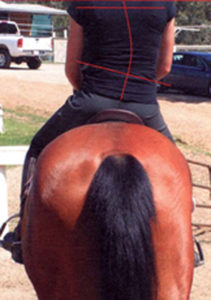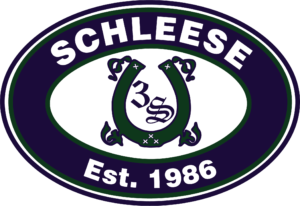Saddle Fit and Saddle Straightness
Here’s a common situation:
 When I have the saddle on the horse, the tree fits, the panels are leveled, and the rider is sitting in balance on both her seat bones, so statically everything looks ok. Then the horse starts moving. The saddle does what is has to do, it stays in place and at this moment I am satisfied what I see, how the saddle is working for the horse. But then the rider sits ‘crooked’ in her saddle. 9 out of 10 times the problem begins in the pelvis and legs. Most riders compensate in the lumbar part of their back. Then the upper body gets involved – most of the time they have a rotation somewhere in their back, one of their shoulders is higher than the other shoulder and on that side they have their hand higher.
When I have the saddle on the horse, the tree fits, the panels are leveled, and the rider is sitting in balance on both her seat bones, so statically everything looks ok. Then the horse starts moving. The saddle does what is has to do, it stays in place and at this moment I am satisfied what I see, how the saddle is working for the horse. But then the rider sits ‘crooked’ in her saddle. 9 out of 10 times the problem begins in the pelvis and legs. Most riders compensate in the lumbar part of their back. Then the upper body gets involved – most of the time they have a rotation somewhere in their back, one of their shoulders is higher than the other shoulder and on that side they have their hand higher.
When I take the saddle off then the dust pattern is good, but I have a little more dust on one side, mostly the side where the rider is sitting “heavier”.
When I look at the form and the experience I have, then I think the rider has a big influence on how “straight” the horse is. I have only seen a couple of horses where the trapezius and the long back muscle were even. Both horses where ridden with a saddle with an adjustable tree, and their riders where almost “straight”.
When you want to protect the horse against long term damage, you also have to “help” the rider. But that isn’t really our job as saddle fitters. The trainer says the horse is the problem because it is crooked. So do I adjust the panels so the rider is less crooked or leave it as it is? Does the rider have the responsibility to take care of his body so she won’t ‘damage’ her horse?
There are 3 possibilities which the saddle fitter, trainer and rider have to choose from, based on the individual circumstances, which will work for today – as I believe, there is more than just one factor which can influence the horse’s or rider’s physical conformation within a very short time frame. (Photo courtesy of Dr. Joanna Robson, DVM)
(A) The panels can be adjusted to compensate if the rider is ‘structurally’ uneven.
(B) If the rider has poor posture then the rider needs to work on her own straightness with strengthening exercises (Pilates, for example). The saddle should never be a seat prosthetic. The saddle is there to protect horse and rider from long term damage and not to be used as a crutch if the rider has no body control.
(C) If the horse has a larger left shoulder, then the saddle will sit straight in the static fit but in the movement the larger left shoulder will push the saddle to the hollow side (the right side). In this case a geometric adjustment should be done on the saddle by opening the left side of the gullet by ‘x’ cm and supporting the right by the same amount of ‘x’ cm as well. This way the saddle has an opening on the left side and room for the larger left shoulder to come through without pushing the saddle to the right during movement.
One of the things I see often – even in professional pictures in various magazines – is that the rider is not sitting straight on the horse (this is especially obvious when you see the rider from behind!).
As a rider, ask yourself: Do you often have to step into one stirrup while riding to center your saddle on your horse’s back? This could mean that your saddle does not sit straight on your horse’s back, for whatever reason.
Once you have determined that your saddle has a gullet/channel that is the appropriate width for your horse, its billets are properly aligned, and it is the correct length for your horse, you need to make sure that it sits straight on your horse’s back. Straightness means that the center of the saddle is in alignment with your horse’s spine. Sometimes, a saddle that appears straight when the horse is standing in the crossties will shift to the right or left when the horse is being ridden. A saddle that falls or twists to one side can lead to problems with your horse’s SI (sacroiliac) joint; if the saddle shifts to such a degree that the panels rest on the horse’s spine, this can lead to irreversible damage I will discuss in future blogs.
The rider too will suffer issues by constantly having to compensate this shift to one side by weighting the opposite side of the saddle with more pressure to be able to continue to ‘feel’ straight. All sorts of long term musculo-skeletal problems will arise – which may be initially brushed off as minor inconveniences instead of indicators of long term pain and problems.
The best way to determine if your saddle falls or twists to one side while your horse is being ridden is to do a dust pattern ride and analyze the results. Without brushing your horse’s back, tack him up and ride him on a 20-meter circle in each direction at the walk, trot, and canter. Then, carefully lift the saddle off of his back, so as to not disturb the telltale outline left by the saddle’s panels. Put your horse in crossties if available; if not, have a friend hold your horse on even ground. Square up your horse. Put a mounting block or something on which you can safely stand behind your horse; the goal is to have a clear view of the top of his back. Stand on the mounting block and look at the dust pattern. Was your saddle sitting nice and straight on your horse’s back? Or did it fall to the right or to the left? If you are uncertain, take a tape measure and measure the distance from the center of your horse’s spine to the outside of the rear panel on each side. If the saddle falls to the right, which is most common due to the usual somewhat greater musculature on the left, the measurement from the center of your horse’s spine to the outside of the right-hand panel will be bigger than the measurement from the center of his spine to the outside of the left-hand panel.
What causes a saddle to fall to one side of a horse’s back? Horses are by nature uneven. The overwhelming majority of horses are not built symmetrically through their shoulders. Most horses have a left shoulder that is larger and more developed than their right shoulder; some have a right shoulder that is larger and more developed than their left shoulder; and a small minority are even through the shoulders. (Approx. 70-20-10%) Whether a horse is left- or right-side dominant can result from the way it was positioned in utero, and/or from which leg is forward when the horse grazes, and/or from the way the horse has been trained. Sometimes a saddle falls to one side because the gullet/channel is too narrow and/ or the tree width or tree angle is not correctly adjusted for the horse. So the larger shoulder kicks the saddle over to the other side.
Alternatively, a rider who sits unevenly can compress the stuffing more on one side of the saddle, and drag it over to that side. Perhaps the rider has an imbalance such as is caused by scoliosis, or one hip is lower than the other, or s/he weights one stirrup more than the other. If you have determined that your saddle does not sit straight on your horse’s back, it is important to determine the cause and resolve the issue in order to avoid causing long-term damage to your horse and to yourself.
